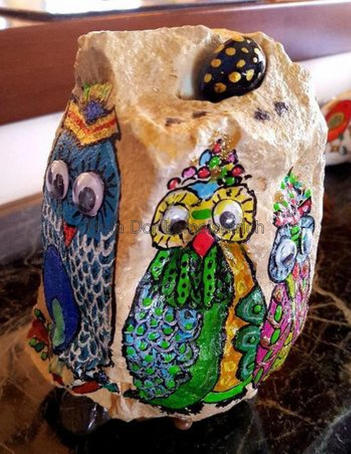
Drawing on stones and pebbles
I have been painting for as long as I can remember. On paper, canvas, walls, paper napkins, in the sand using a stick, and even with my finger illustrating in the air. In recent years I have found myself being inexplicably attracted to stones, pebbles and rocks; and on every excursion or walk in the street I find myself gazing downward, seeking that special stone which will beckon to me to bend down and pick it up.
Stones have been part of Nature from time immemorial. I think that they are the most ancient matter present on the face of the Earth. They have been witness to everything. They have seen the world go through immense upheavals, with new cultures appearing on the scene and others perishing; they have seen how the face of Nature can change beyond recognition, with life forms reaching extinction to be replaced by others, including Man himself. They will also remain long after humans have ceased to exist on this Earth. In many cases they can teach us about the existence of the human species in its various metamorphoses, about an exciting prehistory covering tens and hundreds of thousands of years and far beyond.
All over the world there are rocks and stones that have been altered by human hands: stone surfaces that have been carved, painted, coloured, arranged in mysterious configurations and telling a story that is usually beyond our comprehension. No two stones of any kind are identical. Their composition varies according to their chronological origin, geographical location and source, with each one having its own individual texture, weight, colour, shape, composition and history. Often they can provide geologists and scientists in various fields with marvelous information about past upheavals that the planet has undergone.
Stones may be mute, but preserved within them are countless stories from time immemorial about the sun, the atmosphere, the sea, precipitation, water in its various forms, as well as light and darkness.
All of these aspects are imprinted on every stone on the Earth’s surface, and I often try to imagine the appearance of rivers of stone in the bowels of the Earth, after dramatic transformation by extreme heat into glowing, colourful molten form.
Where do the stones that I collect come from? What changes have they gone through? In every place that I visit I seek out the stone that bears some meaning to me. For reasons unknown to me, I collect them obsessively. Occasionally, I keep a stone in my hand and after a while I will suddenly know what to do with it. Some of them have a form which naturally suggests either some kind of animal, a face, perhaps a strange house or a contorted body. Also their natural colour often will determine what I should do with them. The crystal and mineral components of rocks and stones impart amazing colours to them. One stone that I found by the side of a brook in Slovenia was shaped like a frog and had a brilliant green colour. I clearly knew what to do, which was actually to add very little to it because the stone had everything in it and resembled a fossilized frog.
I leave some of the stones in the natural state in which I find them, as they can tell their story themselves without any need for my help. They stand on their own merit, are impressive by their own right and are timeless. There is something about them that suggests stability, in complete contrast to the transience of contemporary times, the rapid mutability of things and the appearance of the new materials that sprout like mushrooms after a rainfall.
I feel as if Nature has granted me a wonderful gift that affords me many hours of pleasure, curiosity, tranquility, satisfaction as well as a chance to commune with other times. Without a doubt there are many rocks and stones awaiting discovery that will yet one day be able to tell their exciting stories.











